In addition to this material.
Phased installation of a ventilated facade of wooden houses
In order for the facade system to fully meet the requirements of reliability and durability, and also perform its functions well, when installing it, it is necessary to observe certain rules.
- Traditionally, for the construction of wooden houses, a beam of 150x150 mm is used, and in order to maintain a comfortable temperature in the cold in the rooms, care should be taken for additional thermal insulation. As a heater used material from mineral wool thickness of about 10 cm. It is attached to wooden ceilings with the help of special dowels.
- Before you begin the installation of the insulation layer of the facade structure, you should install a profile crate on the bearing walls of the building - this will be the frame for the finishing material. In its niches, mineral wool insulation is subsequently laid.
- The stage following the installation of the battens and the layer of thermal insulation is the fixing of the film, which serves as a membrane protecting from wind and moisture. The insulation will be waterproofed from the outside, while evaporation of moisture from the walls of the house will be removed without hindrance.
- The final step in the arrangement of the wooden ventilated facade is the facing. For finishing it is also desirable to use wood materials, most often block house is used. The choice of quality of finish is determined by its cost, performance characteristics and appearance. The natural tree will not break the harmony of the whole building object.
The facing material is fixed mechanically (using screws, clamps or other means), taking into account the thickness of the gap for ventilation.
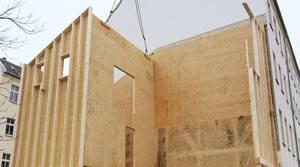
The main functions of exterior decoration - decorative and protective. Simultaneously with the attractiveness of the exterior of the house, the facade layers will be protected from adverse weather conditions.
Moisture, evaporating from the wooden supporting walls, accumulating from the inside on the surface of the facing material, can be easily removed due to the existing ventilation system: air flows moving between the layer of thermal insulation and finish, will drain condensate and excess moisture. Thus, the insulation will not get wet and will retain its thermal insulation properties for a long time.
Read the same article about on our website.
More details about the stages of installation of a ventilated facade made of wood can be found by step-by-step video instructions.
Installation of a hinged wooden facade using the example of a planken
What are the wooden ventilated facades
Types of facade systems
Ventilated facades of wood are divided into Two types, different in structure and functions.
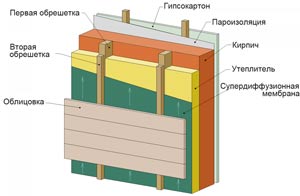
1. A full system of ventilation with a heater.
The main tasks of such a system are not only to protect the structure from weather conditions and to maintain favorable moisture permeability conditions, but also to increase the level of the thermal insulation properties of the building. The use of this type of ventilated facade is common in areas with a harsh climate, where the period of cold weather is much longer than the warm season.
2. Lightweight ventilation system.

The peculiarity of this type of wooden ventilated facade is the absence of a layer of thermal insulation, in connection with which the main function of the structure is to control the moisture level of the building. The use of a lightweight ventilated system is justified in southern regions with a mild climate, where air temperatures predominate, so there is no reason to insulate the structure.
The construction of the lightweight ventilated facade provides only for the presence of a thin frame system that does not have removals, and a finishing material. As the lining can be used various materials: Block House, siding, lining. Installation of the system is not complicated, even an inexperienced builder will cope with it.
Types of wooden finishes in ventilated facades
In addition to the materials mentioned earlier, other kinds of wood can be used for facade cladding.
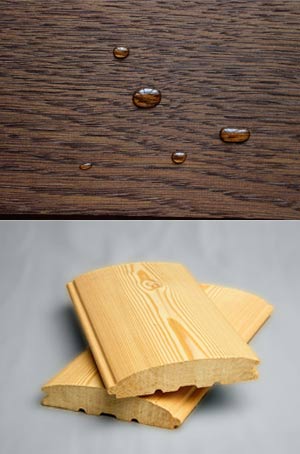
- Thermo-tree - lightweight lumber (almost half the weight of untreated wood), characterized by ease of handling, reliability, practicality. Finishing with a thermo-tree improves the appearance of the building due to attractive decor.
- The larch board (block house, lining) is best manifested in the area with a high level of humidity, because the larch does not rot.
- Exotic heavy wood species. Applicable, due to their properties, to strengthen the skeleton of the facade system and improve the reliability of fasteners. High price finishing materials from exotic species of wood is compensated by unique decorative properties.
Installation of a wooden ventilated facade is not so complicated in execution, if you act, observing its stages and taking into account all the nuances. The result of work will be a comfortable and reliable house, which will serve the owners for more than a decade.
Log, cozy and beautiful, with its unique smell - the dream of many, but only wealthy people can afford it. Wooden facades A worthy alternative to such a house. Their appearance, durability and practicality depend to a great extent on the choice of the cladding material.
Facing the facade with chinaware (shingles)
For facing the facade with wood, many choose shingles - thin wooden plates that resemble clay tiles in shape.
Of all the variety of this material (shindel, shingle, shingle), only the chindle is ideal for facing the facade. About it and will go on speech.
There is a crushed and sawed spindle. Crushed is more expensive, as, firstly, it is made exclusively by hand, and secondly, because the shingle is divided along wood fibers, it has an exceptional mechanical strength. But, nevertheless, this material is more used for roofing.
To obtain a smooth and beautiful facade of wood, a sawed chindle is needed. They make it from: larch, oak, pine, spruce. There is shingles with radial and tangential sawing. Mechanical method processing greatly reduces the cost of production and allows you to get a board of any size and shape.
useful in work
The figure above shows the boundaries of the sizes used and the most popular shake configurations. But, unfortunately, after such processing, the tree strongly loses its moisture resistance and strength characteristics.
Choose a chindle
When buying a spindle of imported production, pay attention to the marking of this facing material.
- 1 grade is marked with a blue label.
- 2 grade is marked with a red label.
In shavings with radial cutting, strength characteristics are better, but the material with tangential cutting can convey the entire beauty of the wood texture. In terms of the "price-quality" ratio, tile from larch is leading. The manufacturer claims that it does not require any additional processing other than sawing.
Mounting of the facade from the spindle
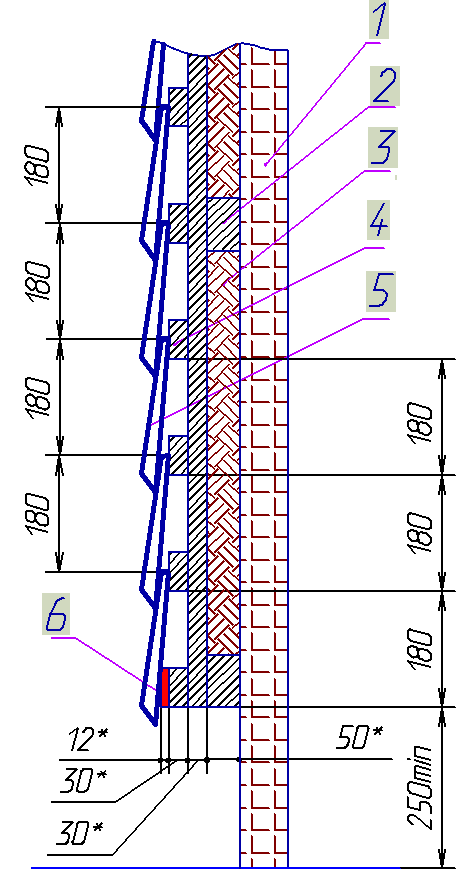
- - the wall of the house
- - Guide
- - insulation
- - controllable
- - front chindle
- - bar for obtaining the angle of inclination
Advantages of the facades from the spindle
Suspended wooden facade from shingles has a lot of advantages. It is perfectly suited for severe climate: low temperatures, a lot of precipitation, sharp temperature changes - the spindle will perfectly transfer all these unfavorable conditions. The technological gap between shingles and insulation does not allow condensation to accumulate, improves the thermal and sound insulation characteristics of the building.
Facing with a planken (front panel)
Planken is wooden plank with length-treated ends. Use it for the manufacture of facades made of wood with a ventilation gap. The board is produced with a width of 7-14 cm and a thickness of 1.5 and 2 cm.
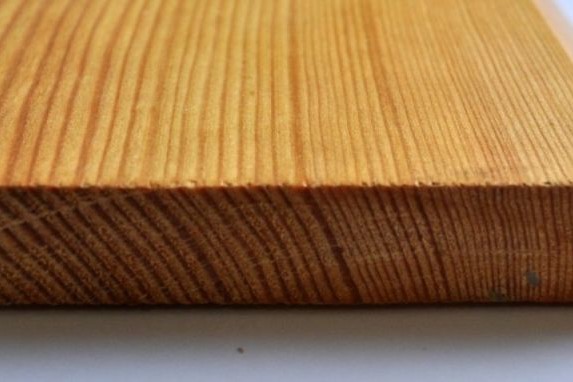
When mounting all the profiles shown in the figures above, leave the technological gaps for ventilation, but only the oblique plank, due to the shape of its section, overlaps them. Such facades made of wood give the house a noble appearance and reliably protect the walls from the weather.
With the concealed method of installation, the facade boards are fixed to each other by metal fasteners. So, for a "rectangular" profile, use a "key" and "snake" mount. The profile with grooves is recommended to be fastened with "crab" and "bridge". Well, the oblique planken is held on the crate with the help of a "snake".
Open method of installation is simple and simple - boards are screwed with galvanized screws to the crate.
Choose a planker
Each of the types of wood used for manufacturing planken has its advantages and disadvantages.
- Larch does not rot and is not inferior in strength to oak, but it can be polished and has high parameters for shrinkage and cracking.
- Pine - a tree with soft wood, not textural, for the production of facade boards often comes pine varieties of AB. Serious minus - with heat treatment knots can drop out. What is the plus? Essential is an affordable price.
- Ash, oak, cedar - high-strength, hygroscopic and durable wood. The only drawback is the high price.
useful in work
Take into account that the oak must be regularly treated with the composition of the fungus.
Installation of the facade of the planken
Let's talk about installing a slanting planken. Of the used profiles, this is the most popular.
- We lay out the planks on the ground for carrying out the control assembly. The shield assembled by us from planken in size should be equal to the height of the facade. Do not forget to leave ventilation gaps (2 - 10 mm) between the boards.
- Mark on the boards where the "snakes" will be screwed (in the places where the crate passes). An example is shown in the figure.

- We fasten to each planken "snake" in such a way that the fastening would go over the edge of the board for 1-2 cm.
- The lower protruding edge of the "snake" is pushed into the gap between the vertical beam of the crate and the bottom board. This moment is shown in the figure. The upper edge of the "snake" is fastened with a screw to the bar of the crate.

Advantages of the facades from the planken
All the advantages of a similar facade, one way or another, are associated with ventilation gaps. The tree, like any material, expands when heated, and returns to its original dimensions when cooled. Gaps compensate for temperature movements, do not allow the facade to deform and warp. In addition, the facade of the planken does not swell because of moisture trapped in the groove. If one of the boards is damaged, it can easily be replaced without resorting to large-scale dismantling. When constructing houses, they frequently use lining with palanquin, because such a building looks beautiful and status.
Front paneling by Block House
Block House (BH) is a kind of lining that imitates a rounded log. Sometimes this material is also called a wooden siding. It is made from spruce, larch, pine, cedar, aspen, birch.

How do they receive BH? Cut out the beam from the central part of the log, and the edges go to the BH. As well as conventional lining, the ends of BX are processed for the connection "groove - spine". On the inner flat part of the BC there are notches. Adjacent to a flat surface, they form channels (grooves), through which the facade is ventilated. In addition, they relieve tension in the tree and increase its heat-saving ability. In Figure 5, you can see the BH in the cross section.
Choose Block House
How to choose a quality BH? According to the European standard, it is produced in three varieties: A, B, C (A is the highest grade). The parameters that determine which grade to include the product are: the number and color of knots, cracks, chips, wormholes, coloring and much more.
For plating large areas use pine BX grade AB, where the ratio of "price - quality" is optimal. BH is available in standard lengths - 3 and 6 meters, and six-meter, (at a price per meter) will cost more. Width of it:
- for external works 40 - 45 mm;
- for internal works 20 - 25 mm;
Council from the "facade"
When buying, pay attention to what the width is indicated in the label - the total (with a spike) or working (without taking into account the spike). The amount of BH that you need for the facade is considered to be the working width.
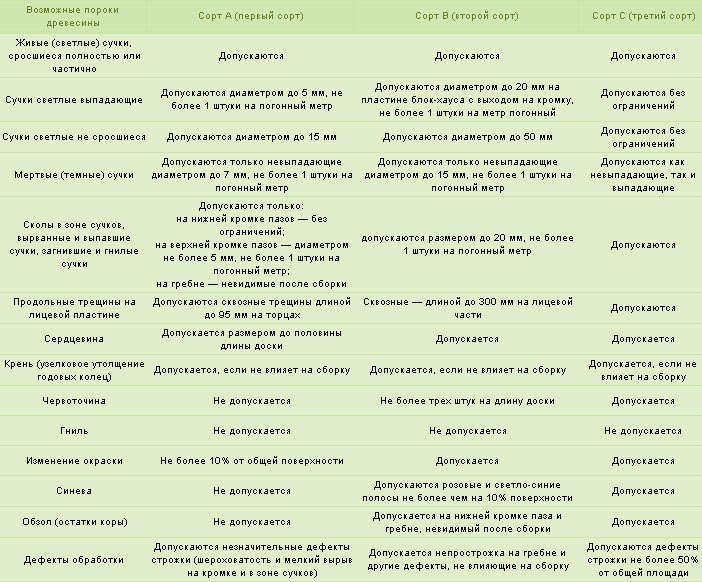
Advantages of Block House
BH - environmentally friendly and strong material, looks aesthetically (the house can not be distinguished from a real wooden frame). If the wooden siding has undergone special processing, then the lifetime of such a facade will be about 70-80 years. But this facing material also has disadvantages. Low vapor permeability of this material can lead to the formation of condensation between the walls of such houses and BH. BH requires painting once every 1-2 years, otherwise the moisture will penetrate the "spike-groove" joint, and the tree will swell and crack.
Installation of the facade of Block House
Facing houses Block House something reminiscent of the installation of the roof - the same principle of multi-layer pie:
- We fix the vapor barrier (membrane films, polyethylene) on the wall of the house. We make the crate from a wood bar treated with antiseptic and fireproof composition. The step of the battens should approximate the width of the insulation boards.
- We stack heat-insulating plates. We fix them with dowels.
- Cover the insulation with waterproofing, attach it with a stapler to the bar.
- We make the leveling crate from the bar 50x50 mm.
- We begin the installation of BH. At the same time, each board should be set up with a spike, so that water does not get into the groove.
- Siding is fixed with self-tapping screws to the crate, and we do it as close as possible to the spike, so that the upper block house closes the lower anchorages.
Our company conducts the facade cladding wooden house. The cost of finishing is calculated at 250 r./m2. Here you can order installation of all types of ventilated systems, facade panels and brick facing. Our company is responsible for the quality of work and provides a guarantee of work for three years. In this article we suggest that you familiarize yourself with several technologies for finishing the walls of houses made of wood.
Recently, wooden houses have become very popular. This is not surprising, because it is almost the only option for clean housing. It should be noted that in connection with increased demand for houses made of wood, materials for their facing have also become popular. When choosing a particular material, it is first determined with their purpose and what the finishing functions will be.
What is the decoration of the facade of a wooden house?
The main task of facing a wooden house is to increase the life of the building without major repairs. There are several types of facade functions:
- Decorative function, which have facades wooden houses. Is one of the main factors in choosing building materials. Since most people want their building to look neat and beautifully the various types of cladding a wooden house are created to help them.
- Protective function. The finishing of the facade of the wooden house should protect the walls from rodents, insects and putrefaction. Especially it concerns houses made of wood, because their material is a bait for small rodents. In addition, weather conditions can adversely affect the condition of the tree, changes in temperature and humidity can lead to decay of the tree. And a prolonged accumulation of moisture will cause the walls of the house to begin to deteriorate. Exterior finish The facade of a wooden house will provide protection from this. For example, there are a number of special antiseptics that treat wood before use. You need to apply them with a certain periodicity.
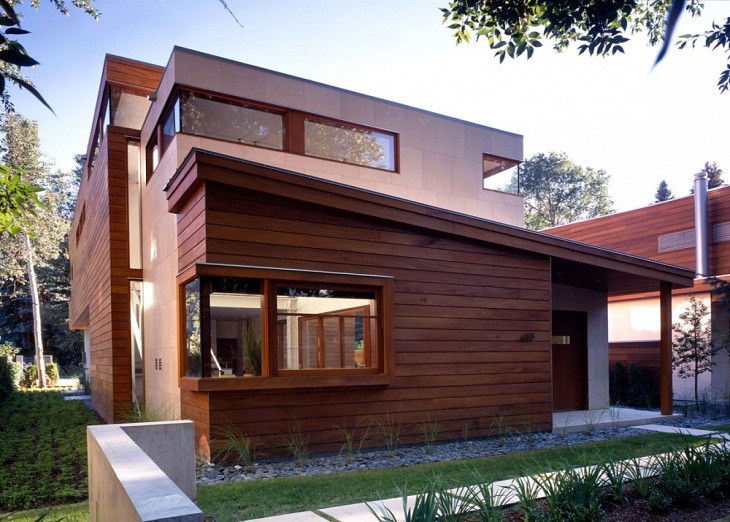
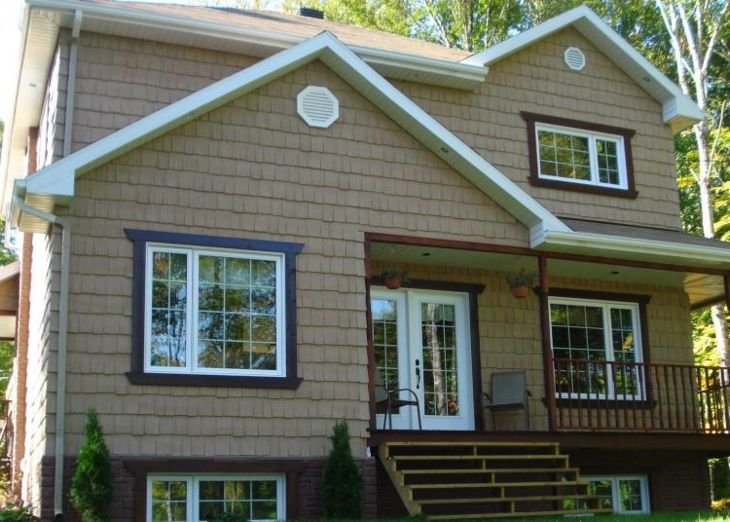
Veneered wooden structures are easy to clean, they can be wiped with a damp cloth. In addition to the pluses for finishing the facades of buildings it is worth adding an excellent level of noise, sound and heat insulation. Winter in your cottage will be kept warm, and in the summer - cool.
Modern building materials for finishing the facade have non-flammable properties that will protect you from fire.
What materials are used for facade cladding?
The most popular are:
- facades, finished with plaster;
- facade of the house, finished brick;
- facade trimmedclinker heatpanel;
- facade trimmedblock house;
- facade trimmedsiding.
We will tell you about the pros and cons of each material for lining.
Facing the house with plaster
Plaster for houses from a tree does not suit very much, it is necessary to resort to it only if no other method can be used. Put plaster directly on the uneven bars - it will crumble. Therefore, in the beginning, the walls are lathed, that is, the waterproofing is put on, the slats are stuffed with it or the lath is set.
Plaster can be ordinary, and can have sand and cement mixture. For example, if you want to achieve a light color, we recommend paying attention to mineral plaster. It is made of plasticizing materials. Acrylic plaster is good air-permeable, well-kept and has a rich palette of shades. However, acrylic plaster does not have such a long service life as mineral plaster. If you want to give originality to your facade at home, use plaster with crumbs of various minerals.
This kind of facing the house is available to almost everyone because of its cheapness. A variety of colors, shades and textures allow you to experiment, embodying the most daring ideas on the facade.
The disadvantages are finishing the lining of the wooden house - changing the appearance of the wooden house, the laboriousness and the need for painting.
Facing the house with a brick
Facing bricks, unlike ordinary bricks, have clear geometric shapes, distinct clear, straight angles and facets. When installing, the front side must be flawless.
How to make the facade of a wooden house
The process of facing the facade of the house must begin only after the house has completely shrunk. Since wood is such a material that requires ventilation, install the lining at a distance of 5 cm from the wall. If, as a material, you chose a brick, fix it to the wall, it should be with the help of Kleimers.
It is worth noting that facing brick must be installed with special attention, because any inaccuracy will be in sight and spoil the impression of the house. In addition, the work of finishing the brick affects the mass of the walls, which gives an even greater load on the foundation. If the building is not originally built taking into account the brick facing, it is better to choose another method. The pluses include refractoriness, high level of thermal insulation.
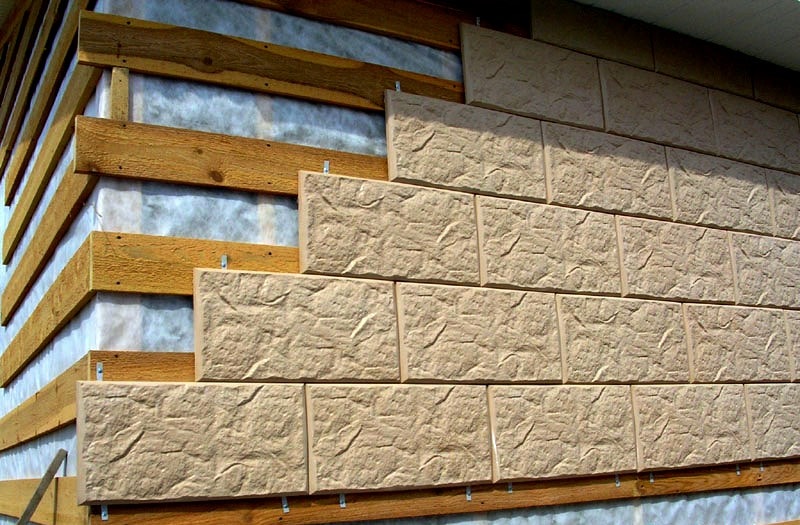
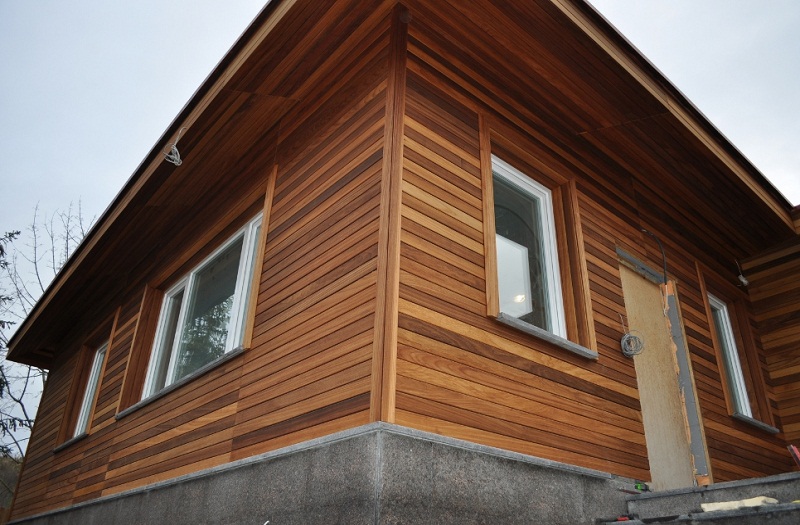
Despite the many advantages of finishing any wooden house, there are several disadvantages. First, the facade of a wooden house will look different. Now, at first sight it will be unclear what is it wooden house. Secondly, the mass of walls and the pressure on the foundation increase.
Clinker heatpane cladding
Clinker heaters are a foam polyurethane with glued clinker panels. Using this material will solve two problems at once - thermal insulation.
Such panels have a high level of vapor tightness, increase heat and waterproofing, differ in low weight, tolerate changes in temperature and humidity, are fireproof and are not subject to the influence of various acids and alkalis. In addition, such panels can be installed independently. A wide range of colors can be added.
Facing Block House
Block house is a special material widely used in finishing such a facade of a wooden house. It is ideal if you want to keep the exterior of the house. This material is an imitation of a cylindrical log, although the inner side is perfectly flat. The block house is installed by means of a special spike-groove system, which is located at the end of the panels.
This panel made of natural wood, covered with a special antiseptic from decay and exposure to insects. In addition, plus this material is that the installation of installation is inherently uncomplicated.
In the cons can be attributed a high price, after the time the panel needs to be reinstalled.
Facing the house with siding
Siding is a panel of PVC (vinyl). The thickness of this material is approximately 1-1.3 mm. Those who wish to save a little at the stage of finishing will do just this material. It does not have a large mass, so it does not press on the foundation, the speed of installation justifies all the disadvantages.
Siding of domestic production will cost you much cheaper than its foreign counterpart, although their specifications are approximately equal.
A wide range of colors allows everyone to choose the color to their taste. In operation, the siding is simple and convenient, easy to clean from dust and dirt.
There are several types of cladding facades of wooden houses:
- vertical;
- horizontal.
Vertical method. You can use the tile and plaster together. This method is good in the event that the facade of the house is meant to be contrasted with shades. For example, the corners of the building can be laid out with tiles, and the walls of the houses plastered. Tiles under the stone and siding also look good. As in the previous example, the corners are covered with tiles, and the walls are decorated with a siding of contrasting color.
Horizontal finishing of the facade of the house
The name speaks for itself - the material is laid out on the facade of a wooden house horizontally. For example, the base can be made darker, and the walls are lighter. Also, the lower part can be laid out with a stone.
An excellent option for finishing the facade is a combination of tiles and wood. The lower facades of houses should be laid out with stone or bricklaying (so that the foundation is not heavily loaded choose a decorative stone). The facade can be laid out by a clapboard or block house.
